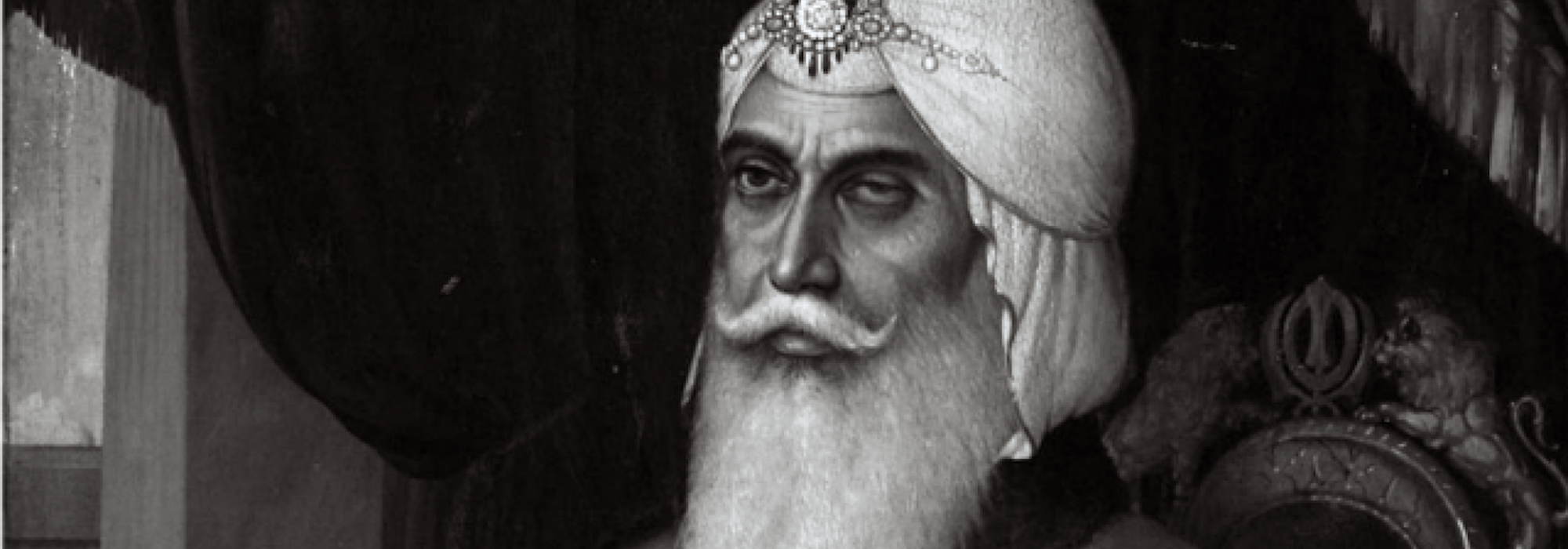Maharaja Ranjit Singh stands in the forefront of this great Sikh warrior tradition. It was Ranjit Singh who reestablished Sanatana Dharma in the North Western regions (Afghanistan and surroundings) of Bharata after the downfall of the Mughal Empire. He was the nightmare of the British.
Born on November 13, 1780, Ranjit Singh lost one eye in his childhood due to smallpox. The force and intensity of his personality was such that even his closest people were unable to ascertain which eye was dysfunctional. Although he was illiterate, Ranjit Singh underwent rigorous military training, and when he was twenty-one, he resolved to establish a Sikh Empire. Accordingly, he earned the title, “Maharaja” at Lahore. Through the dint of his blazing valour, he captured several parts of Afghanistan. Then he invaded Purushapura (Peshawar) and ensured that Mohammad Khan—who was ruling there—fled the place. But he also strictly implemented the rule that on no condition should the vanquished be looted.
Purushapura returned to Hindu control after a whopping seven hundred years. But when he conquered the Sindh region, the British found it intolerable. But Ranjit Singh cared two hoots for them and expanded his empire up to the Khyber Pass. He annexed Kashmir and Ladakh as well. However, when he attacked the Kangra Valley in Kashmir, the Gurkhas gave him stiff resistance. Deeply appreciating their valour, he won them over with his magnanimity. In this manner, Ranjit Singh extended his empire from the Sutlej River to the Khyber Pass, and from Tibet to Sindh.
Ranjit Singh ushered land revenue reforms and implemented an agriculture-friendly policy. In the early days, although there was no dearth of valour in the Sikh army, there was a lack of systematic organization. Despite being short of numbers, the British were a well-organized force. Sensing this crucial drawback, the shrewd Ranjit Singh disguised himself, observed and learnt the British methods of military training and organization and adopted the same methods in his own army. He appointed anti-British officers to train his military force—from such diverse nationalities as French, Italian, Greek, German, and American. This is the adroitness that Ranjit Singh displayed in readying up his army.
He also implemented the system of Panchayat Raj with strict and well-defined policies and rules. The German traveler Karl Van Hugen writes: “In the dominions of Ranjit Singh, there were few criminals. He had constructed roads, hospitals, rest houses and schools. He regarded all religions with equal respect.”
Maharaja Ranjit Singh had a prodigious memory. He had the names of and knowledge about the conditions of 1200 villages under his suzerainty in his memory. He would jokingly say that God had taken away one eye so that he would treat all religions the same.
He applied laws uniformly to everybody in his kingdom. This doughty Kshatriya minted coins and named them “Nanakshahi” in the honour of Guru Nanak and called his court as the “Khalsa Durbar.”
On one occasion, a bigoted Christian missionary (a padre) named Joseph Ulfa entered his kingdom and began vilifying all non-Christians as cowards and pressurized people to convert to Christianity. When reports of his deeds reached Ranjit Singh, he summoned the padre and said: “When you were seated on the elephant and you were crossing the Sindhu River, even you were shivering in fright in spite of your belief in your own God. Why?” After chastising him in this fashion, Ranjit Singh said with great ferocity, “Don’t blindly assume that all of us are cowards.”
His consort once asked him sportingly: “You are not good-looking. When God was distributing beauty to everyone in equal proportions, where had you disappeared?” Ranjit Singh replied: “I was busy building the Khalsa Durbar of the Sikh Empire with single-minded dedication.” By all counts, Ranjit Singh was a fierce warrior and an able administrator.
Maharaja Ranjit Singh lived for sixty years. However, he could have been more strategic while dealing with British and he had every opportunity to kick them out of our country. However, the bitter truth was the fact that if he launched a frontal attack against the British, all Muslims would unite against him. No one can say with certainty but this could be a reason for his hesitation to take the British on. Be that as it may, this move of Ranjit Singh wasn’t exactly wise. However, at no point in time did he behave as a subordinate to the British. On the contrary, he was on equal terms with them. At a later point in his life, although the fabled Kohinoor diamond came to his possession, he gifted it to Queen Victoria! Such actions are what precisely qualify for the follies of great people.
In the final assessment, the hoary credit for taking the Khalsa Panth to its most glorious epoch and thereby fulfilling the dream of Guru Gobind Singh entirely goes to Maharaja Ranjit Singh.
To be continued















































